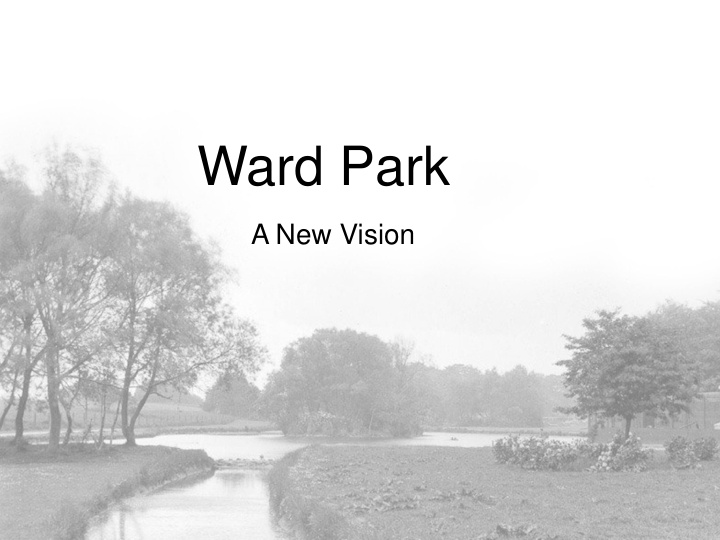



Ward Park A New Vision
• Designed by competition 1909 • Much loved and unique town park • Famed for its waterfowl and aviaries • Mix of passive and active recreation • Gives children first experience of wildlife
• Watercourse source in Craigantlet hills • Ponds act as local flood plain • Ponds subject to siltation • Reduction in water depth and quality • Effect on habitat quality
• Ward park an important ‘green lung’ close to the centre of Bangor. Trees, water, grassland, flower beds, shrubs. • Range of tree species, habitat for birds, bats and insects. Three ponds aligned along a small river – Sticklebacks, eels and aquatic animals. • No water Plants. Reduced Water Quality. Large numbers of waterfowl. Grassland neatly maintained • Wildlife & natural environment act 2011 places a statutory duty on all public bodies to ‘…further any function…’ biodiversity action plan. • Vision: Make ward park a better place for wildlife & people. Give it a more natural feel. Enhance habitats • Display avian collections in a modern environment • Examples from Glasgow and London. No current examples in northern ireland
Taking the 1909 Design into the 21 st Century • Existing inlet silt trap needs to be upgraded • Ponds need to be de-silted • Existing pathways constructed in tarmacadam and beginning to degrade in places • Existing pond edges and copings in poor repair • Existing bridge structures/accesses are not DDA compliant • Existing tree stock requires enhancement and safeguarding for the future • Lack of planting to the pond edges • Multiple mix of street furniture types including benches and bins • Poor street lighting • Opportunity to enhance/improve and upgrade the quality/character and finishes of the existing urban park fabric
Zone A – Ecology Zone B - Leisure Zone C - Recreational
Upper Pond – Existing Situation High flows at times • Pleasing to the eye • Static water controlled by weir • Vertical pond edges Lacking aquatic plants Water plants absent • Poor in biodiversity
Middle Pond – Existing Situation Japanese Knotweed Waterfowl • Fixed Water level • Hard edges • Lacking aquatic plants • Poor biodiversity • Islands with mature trees • Abundant waterfowl Feeding the ducks
lower Pond – Existing Situation Existing edges and surfaces In poor condition • Fixed Water level • Hard edges • Feature stone bridge • Poor visual links from park entrance • Inlet to culvert at hamilton road
Zone B – Promoting Passive/Leisure Zone A – Enhancing Site Ecology Zone C - Enhancing Active Recreation Recreation • Integration of wetland planting, shallow water conditions and remediation of invasive species to create a stronger • • Centralisation and consolidation of bird enclosures and Enhancement of park entrance and Creation ecological value to the park improvement of the pond edge/pathways and introduction of of new informal seating area with potential for new planting picnic provision
Recommend
More recommend